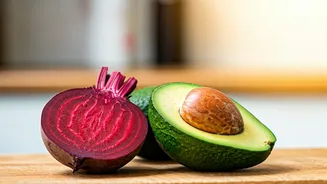Fiber: The Basics
Fiber, often lauded for its digestive benefits, is a type of carbohydrate that the body cannot digest. Found primarily in plant-based foods, fiber is divided
into two main categories: soluble and insoluble. Soluble fiber dissolves in water, forming a gel-like substance that helps slow down digestion and lower blood sugar levels. Good sources include oats, beans, and fruits. Insoluble fiber, on the other hand, does not dissolve and adds bulk to the stool, promoting regular bowel movements. This type of fiber is abundant in whole grains, vegetables, and the skins of fruits. Both types of fiber work together to support a healthy gut, contributing to overall well-being. The impact of fiber goes far beyond the gut, influencing heart health and the risk of chronic diseases.
Soluble Fiber Benefits
Soluble fiber offers a range of health advantages. It forms a gel in the digestive tract, which helps slow down the absorption of sugar, thereby contributing to better blood sugar control. This is particularly beneficial for individuals with diabetes or those at risk. Moreover, soluble fiber can bind to cholesterol in the digestive system, preventing its absorption and helping to lower LDL (bad) cholesterol levels, thus promoting heart health. Furthermore, soluble fiber provides food for beneficial gut bacteria, acting as a prebiotic that supports a healthy gut microbiome. Consuming soluble fiber can also contribute to a feeling of fullness, aiding in weight management by helping individuals feel satisfied with smaller meals. Sources like oats, beans, and certain fruits are excellent choices.
Insoluble Fiber's Role
Insoluble fiber plays a vital role in the digestive process by adding bulk to the stool and promoting regular bowel movements. This helps prevent constipation and reduces the risk of diverticulitis, a condition characterized by small pouches forming in the colon. By speeding up the passage of food through the digestive system, insoluble fiber reduces the time toxins spend in the gut, which may lower the risk of colon cancer. Foods rich in insoluble fiber, like whole grains, vegetables, and fruit skins, also provide essential nutrients and contribute to overall digestive health. A diet rich in this type of fiber keeps the digestive system running smoothly, ensuring efficient waste elimination. This is an essential component for optimal gut health.
Recommended Daily Intake
The recommended daily intake of fiber varies depending on age, sex, and overall health. Generally, adults should aim for approximately 25–30 grams of fiber per day. However, most individuals do not meet this target, highlighting the importance of consciously incorporating fiber-rich foods into the diet. It's best to gradually increase fiber intake to avoid discomfort, such as bloating or gas. This allows the digestive system to adapt. Focusing on a balanced diet that includes a variety of fiber sources, such as fruits, vegetables, whole grains, and legumes, is key. Consulting a healthcare professional or a registered dietitian can provide personalized guidance on how to optimize fiber intake for individual health needs. The right balance is key to achieving optimal results.
Boosting Fiber Intake
Increasing fiber intake doesn't have to be difficult. Start by adding fiber-rich foods to each meal. For example, include whole-grain bread or oatmeal for breakfast. Add vegetables like broccoli or spinach to lunch and dinner. Incorporate beans or lentils into stews, soups, or salads. Opt for fruits with edible skins, such as apples and pears, over fruit juices. Choose whole-grain alternatives to refined grains, such as brown rice instead of white rice. Read food labels carefully and select products with high fiber content. Hydration is also essential, as drinking plenty of water helps fiber function effectively in the digestive system. A gradual and mindful approach will help increase your fiber intake and enhance your overall health.











